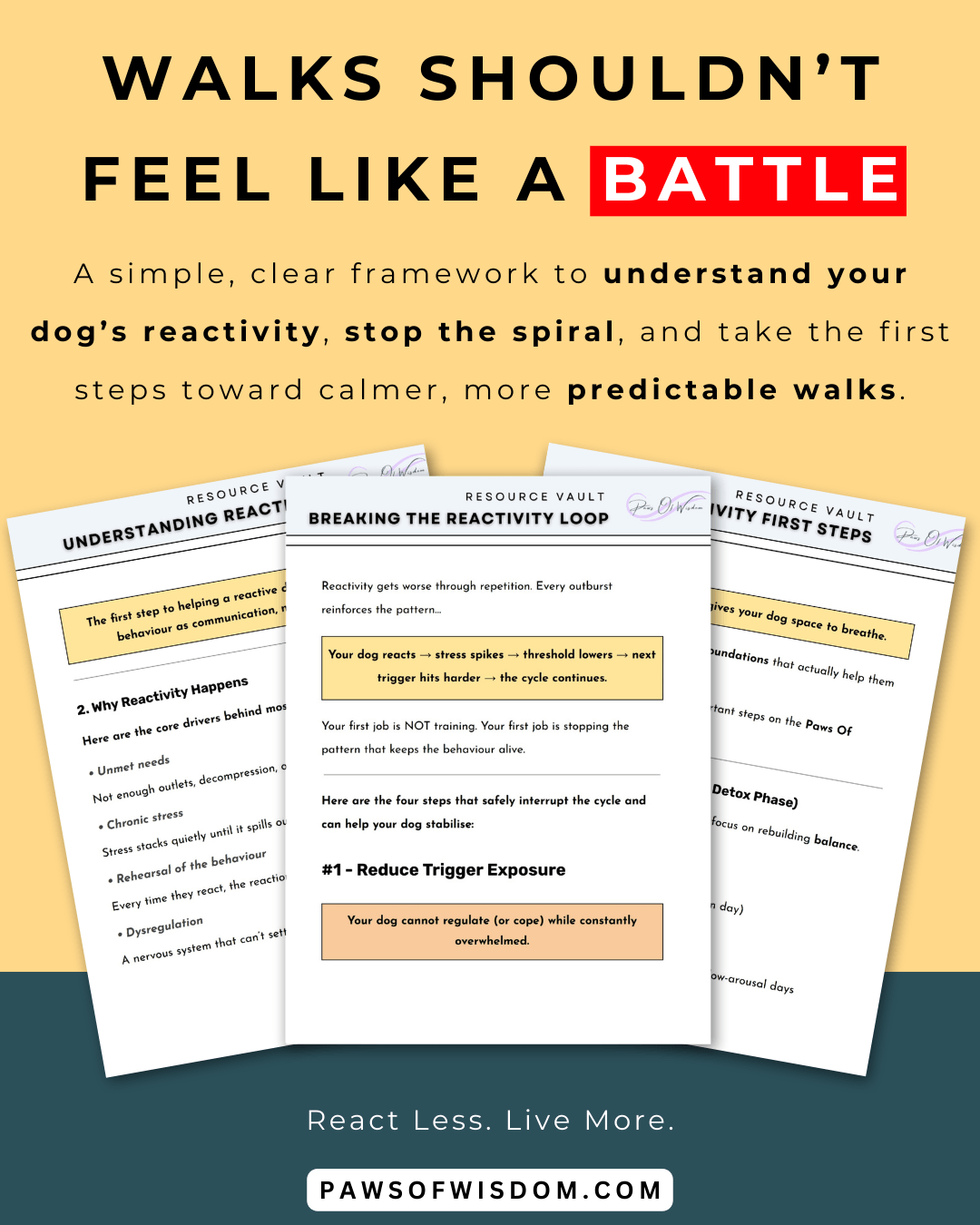The Dog Reactivity Chart: How to Spot Stress Before It Boils Over
Have you ever wished your dog came with a warning light — something to tell you a full blown level 5 meltdown was coming before it hit? That’s where the dog reactivity chart comes in.
I made this simple visual to help you understand the build up before a reaction — the stress signs, the body language, and what each zone means, and what you can do.
In this post, you’ll learn how to use this behaviour chart for reactivity to spot early signals, avoid common triggers, and better support your dog before things escalate.
I'll briefly cover the chart itself, what each stress level means, and how you can use it daily to take the guesswork (and stress) out of your walks.

Introducing The Dog Reactivity Chart
Having a dog reactivity chart can be super useful with helping you understand how to read your dog better and better manage them on your journey together.
This chart/spectrum is a visual tool that shows how dogs typically respond to stress and triggers as they move up the stress ladder — from the calmer green zone, to the more alert yellow zone, to the reactive red zone!
A lot of owners feel like their dogs react without warning, that they just snap and lunge without giving any signs. Saying this, dogs constantly give signals before a reaction, the problem is a lot of owners don't know how to read them or what to do in these situations...but this chart now puts you one step ahead!
This will help you:
Identify when your dog is feeling safe
Spot early red flags before a reaction
Understand how close is too close
With this in hand you will start to read your dog better and learn how to work with them to prevent reactions.
Keep reading and we'll dive into the zones and what to do the next time you find your dog climbing this spectrum.
The Green Zone: Calm, Curious, and Ready to Learn

This is your dog's happy place.
In this zone learning is possible, engagement is high, and your dog is curious, not overwhelmed.
This zone is great for teaching new behaviours and building engagement with your dog.
You'll notice the following...
Relaxed body
Loose leash
Soft eyes
Responsive to cues
Able to take treats
The Yellow Zone: Alert, Distracted, But Can Be Saved

Think of this as troubled waters. This is where your dog will spot a trigger and is processing what to do with that, this is more commonly known as loading. This is the stage where when left to their own devices a dog will load up until they explode.
It is possible to engage with dogs in this zone, your engagement skills might be tested here but you still have time to create space, engage your dog, and bring them back down the spetrum through decompression, play, and movement.
Signs that your dog is in this loading phase include:
Ears forward
Intense staring
Slower response to cues
Hesitation with treats
Muscle tension
Once you start building more engagement and reliability with your dog, you can start pushing the limits a little.
You have to be careful not to overdo it and cause setbacks but if done properly it can be a great learning curve and help speed things up with reactivity.
The key is making sure you build your dogs foundation of engagement skills so that when they are tested in this zone, your dog knows the drill.
The Red Zone: Over Threshold and Ready to Explode

This is the danger zone! Run!
No but honestly, create distance as soon as you can. Your dog won't be able to learn, enagage or even listen to you at this point. This is why we often end up having to drag our dogs away, because theyre is no reaching them past that threshold.
They’re not trying to be difficult — their nervous system has gone into fight or flight, they have very little control in this mode. Training stops. Learning shuts down.
Your job is to avoid this zone as much as possible, but if you end up here, the best thing to do is give something to bring your dog back down such as some scatter feeding or a targeting game.
Expect to see:
Barking or lunging
Hard staring
Unable to take food
Pulling wildly on the leash
Completely ignoring you
Understanding Threshold and Distance
You should have heard the term 'threshold' thrown around a lot...but what does it actually mean and why is it so important?
The way I like to teach people about this is to imagine a bubble around your dog; anything that enters that bubble is something of concern. If we stay with this train of thought, dogs that have small bubbles are normally more confident and comfortable with their environments.
Reactive dogs have a bit more of a safety bubble, some having a ridiculous bubble, but we listen, we don't judge.
The key to avoiding the red zone is knowing your dog’s threshold — the point at which they go from coping to reacting.
Once you know the size of your dog's safety bubble, you can start being more proactive at keeping them under the threshold when training or socialising and in green zones and navigating them out of the yellow and red when needed.
Distance is your best friend...
Too close = panic mode
Right distance = engagement and learning
Stress & Trigger Stacking: The Hidden Drivers Behind Reactivity
Stress is the silent catalyst to a lot of problem behaviour in dogs. When stress builds up — from noise, dogs, people, overexcitement, stimulation, or even lack of rest — your dog becomes a ticking time bomb.
It's normally not the reaction that is the problem, it's the build up — that's the final straw that breaks the camels back.
Barked at in the garden
Overstimulated by passing kids
Loud crash startles them
BOOM — your dog reacts to a leaf blowing past
That’s why rest, decompression, and regulation matter more than obedience sometimes. Because as your dog climbs up the dog reactivity chart; stress builds, thresholds drop, and dogs find it a lot harder (even impossible depending on how far up they are) to listen and follow your guidance.
Once we see our dogs climbing up the spectrum introducing decompression can help bring them back down.
👉🏾 Want to learn more ?
Grab the FREE Paws Of Wisdom trigger stacking guide to discover how this impacts your dogs behaviour?
Only available in the Regulators Community Resource Vault!
Practical Ways to Stay Below Threshold On Walks
Learn their body language
Know what their threshold is
Know what their triggers are
Remember to allow for decompression so your dog isn't left strung out all walk
Train at a safe distance
Meet their needs
Don’t chase progress — build it slowly
Prioritise exercise, rest, and enrichment (your Holy Trinity!)
Keep walk routines predictable and low-stress
Breaking the Reactivity Loop: Why Patterns Repeat
A lot of reactive dogs get caught in what’s known as the reactivity loop — where reacting becomes a habit, not a conscious choice. The more they go over threshold, the more automatic the response becomes. There basically is no safety bubble.
Think of it like a pathway in the brain:
Trigger → Reaction → Relief / Release
Each time it happens, the loop gets stronger. But thankfully, just because it’s repeated, doesn’t mean it’s permanent. You can break the loop — but it takes consistency, clarity, and knowing when to step in.
Ready to Break the Cycle?
The Paws Of Wisdom FREE Reactivity Starter Bundle is designed to help you:
Understand your dog’s stress triggers and threshold
Learn how to interrupt the reaction cycle before it spirals
Build the foundations your dog actually needs (not just more commands)
And more!
Final Thoughts
The dog reactivity chart isn’t just a visual. It’s a mindset shift.
It teaches you to observe, respond, and advocate for your dog before things escalate. The more you use it, the more you observe (and listen to what your dog is saying) the more fluent you become in your dog’s language.
Frequently Asked Questions (FAQs): The Dog Reactivity Spectrum
A dog reactivity chart visually maps out the behavioural signals dogs show as they go from calm, curious engaged, and focused to stressed and reactive. It helps you read your dog’s state and adjust your approach before they hit meltdown mode.
Green Zone – Calm, focused, responsive, and curious
Yellow Zone – Early warning signs like body tension, scanning, fixation, or selective hearing.
Red Zone – Over threshold behaviour: barking, lunging, ignoring cues, explosive reactions.
Dogs move up the reactivity chart when they’re exposed to stressors or triggers without enough recovery time, decompression, space, or support. Each new trigger or stressor stacks up, moving them from calm to overwhelmed — especially when they haven’t learned to self regulate yet.
To bring a dog down the chart, you need to:
Create distance from the trigger
Stay calm and grounded
Offer decompression time
Use simple cues or redirection that they know (only if they’re still mentally reachable)
Prioritise recovery through rest, decompression, enrichment, and reducing trigger exposure
Dogs over threshold often display intense staring, hyperactive behaviour,barking, lunging, or freezing. They may ignore food, cues, and redirection — their brain is in fight or flight mode.
Watch body language carefully and use the chart to know when to increase distance. Stay within their safe “green zone” where learning is possible, and give them space before stress escalates.
Related Reading
A FREE community with downloadable guides and resources, and people who get it.
A simple and structured reset for overstimulated, dysregulated, chaotic dogs.
Simple, clear guidance to help you understand your dog through a regulation-first lens.











